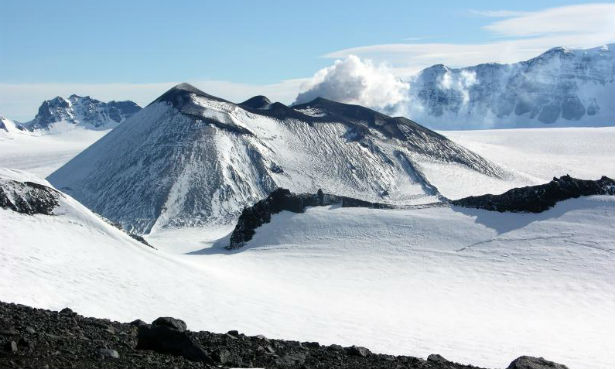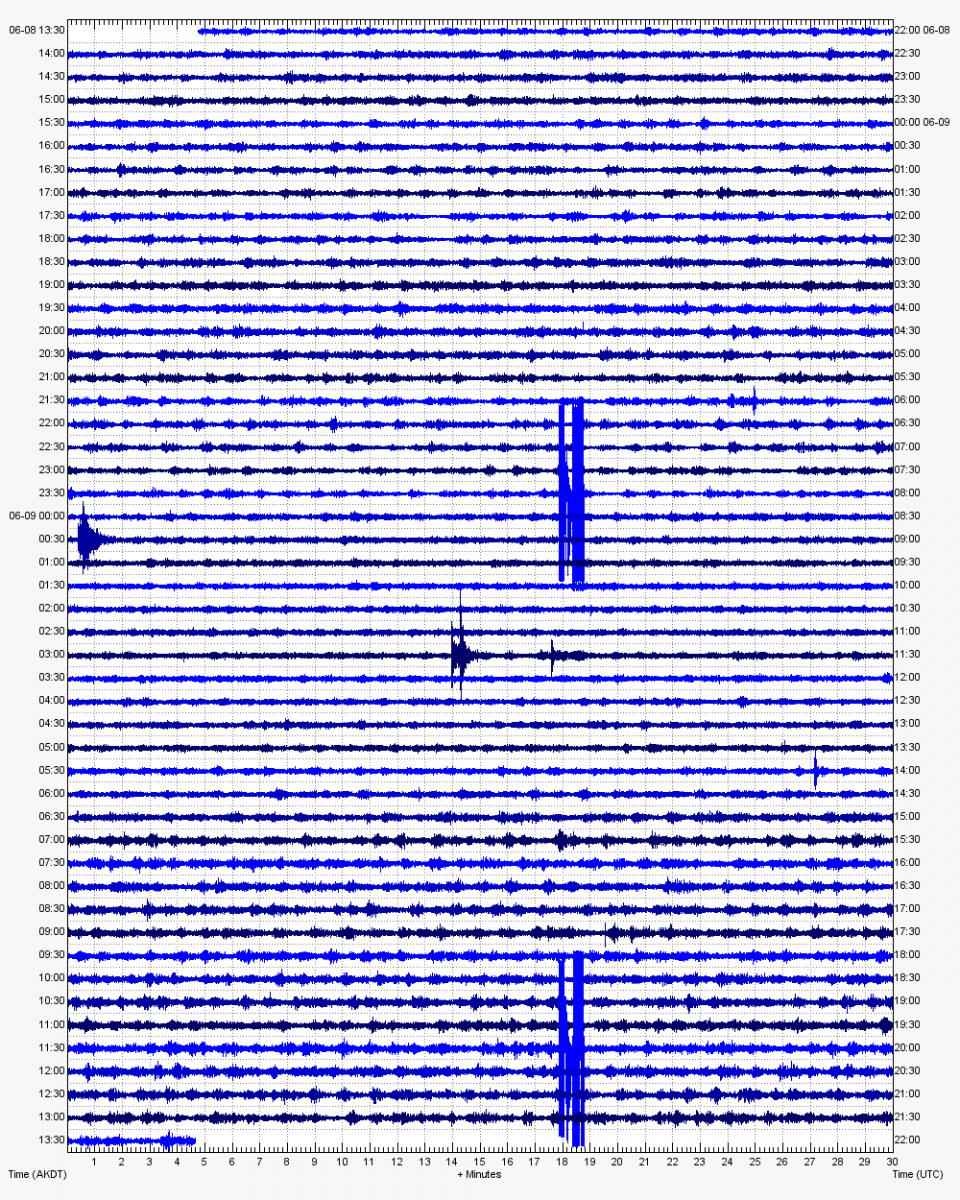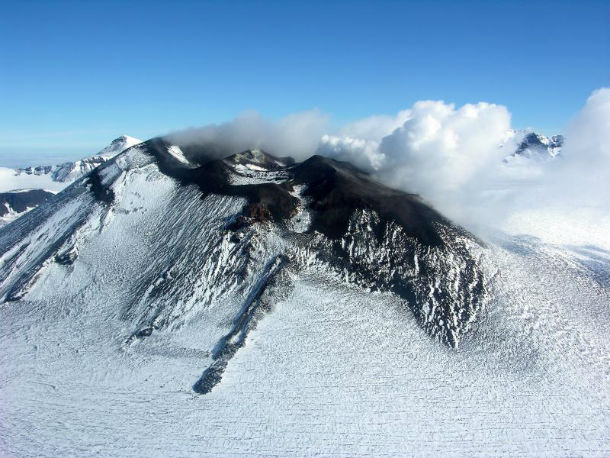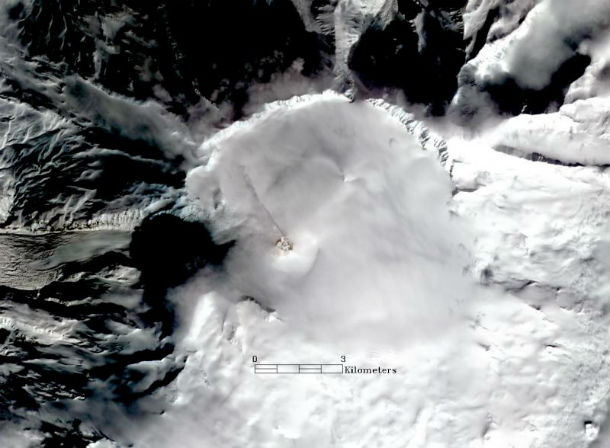Another Aleutian volcano erupts – Increasing seismic tremor and steam plume at Veniaminof volcano

AVO reported on June 8, 2013 that over the past two days, they have detected gradually increasing seismic tremor beneath Veniaminof volcano, Alaska. Similar seismic activity has been associated with ash emissions at Veniaminof in the past, most recently in 2005.
On June 9, 2013 AVO stated that the seismic tremor continues at the volcano, and clear web camera views showed a steam plume over the past 24 hours, though it is difficult to see in daytime views. AVO therefore raised the Aviation Color Code to Yellow and the Volcano Alert Level to Advisory.

Current seismic recording from Veniaminof volcano (Credit: VNHG_EHZ_AV station/AVO).
Mount Veniaminof volcano is an andesitic stratovolcano with an ice-filled 10-km diameter summit caldera located on the Alaska Peninsula, 775 km (480 mi) southwest of Anchorage and 35 km (22 mi) north of Perryville. Veniaminof is one of the largest (~ 300 km3) and most active volcanic centers in the Aleutian Arc and has erupted at least 13 times in the past 200 years. Recent significant eruptions of the volcano occurred in 1993-95 and 2005. Both were moderate Strombolian eruptions producing intermittent low-level jets of incandescent lava fragments, and low-level emissions of steam and ash from the main intracaldera cone.

Intracaldera cone at Veniaminof with steam and possible ash captured on July 26, 2006 (Image courtesy of AVO/USGS/Tim Plucinski)
During the 1993-95 activity, a small lava flow was extruded into the summit caldera ice field producing an ice pit. Minor ash-producing explosions occurred in 2002, 2004, early 2005, and early November 2006. Previous historical eruptions have produced ash plumes that reached 6,000 m (20,000 ft) above sea level and ash fallout that blanketed areas within about 40 km (25 miles) of the volcano.

ASTER (Advanced Spaceborne Thermal Emission and Reflection Radiometer) satellite data provided a mostly clear view of a steam plume emitting from the active intracaldera cone at Veniaminof Volcano on March 4, 2008. No anomalous temperatures were observed in simultaneous ASTER thermal infrared data, though the plume likely obscures the vent. Recent AVO webcam views show that the steam plume is occasionally interrupted with low bursts of ash. This activity is typical for periods of elevated seismicity at Veniaminof. AVO continues to monitor activity at Veniaminof using seismic data, satellite images, internet camera data and observer reports. (Image processed by AVO/USGS. Image data courtesy of NASA/GSFC/METI/ERSDAC/JAROS, and U.S./Japan ASTER Science Team/Wessels)
Massive Veniaminof volcano, one of the highest and largest volcanoes on the Alaska Peninsula, is truncated by a steep-walled, 8 x 11 km, glacier-filled caldera that formed around 3700 years ago. The caldera rim is up to 520 m high on the north, is deeply notched on the west by Cone Glacier, and is covered by an ice sheet on the south. Post-caldera vents are located along a NW-SE zone bisecting the caldera that extends 55 km from near the Bering Sea coast, across the caldera, and down the Pacific flank. Historical eruptions probably all originated from the westernmost and most prominent of two intra-caldera cones, which reaches an elevation of 2156 m and rises about 300 m above the surrounding icefield. The other cone is larger, and has a summit crater or caldera that may reach 2.5 km in diameter, but is more subdued and barely rises above the glacier surface.
VENIAMINOF VOLCANO (CAVW #1102-07-)
56°11'52" N 159°23'35" W, Summit Elevation 8225 ft (2507 m)
Current Volcano Alert Level: ADVISORY
Current Aviation Color Code: YELLOWCLEVELAND VOLCANO (CAVW #1101-24-)
52°49'20" N 169°56'42" W, Summit Elevation 5676 ft (1730 m)
Current Volcano Alert Level: ADVISORY
Current Aviation Color Code: YELLOWPAVLOF VOLCANO (CAVW #1102-03-)
55°25'2" N 161°53'37" W, Summit Elevation 8261 ft (2518 m)
Current Volcano Alert Level: WATCH
Current Aviation Color Code: ORANGE
Pavlof volcano
Ash emissions from Pavlof continue. Seismic tremor and explosion signals accompany the activity. Persistent elevated surface temperatures consistent with lava effusion were observed over the past day in satellite images. Satellite images from June 9, 2013 show an ash plume extending 20 kilometers (12 miles) southeast of the volcano; this direction is consistent with low level winds. Clear views on June 7, 2013 from Cold Bay showed an ash plume rising a few thousand feet above the volcano.
AVO raised Volcano Alert Level from Advisory to Watch and Aviation Color Code from Yellow to Orange. The current activity at Pavlof volcano could become more vigorous with little warning, and AVO continues to monitor the volcano closely.
Cleveland volcano
At Cleveland volcano, Alaska as of June 9, 2013 nothing unusual was observed in satellite images over the past day, and no other reports of activity were recived, AVO stated in the latest report. The agency warns that sudden explosions of blocks and ash are still possible with little or no warning, and ash clouds, if produced, could exceed 20,000 feet above sea level. If a large ash-producing event occurs, nearby seismic, infrasound, or volcanic lightning networks should alert AVO staff quickly. However, for some events, a delay of several hours is possible, as Cleveland volcano does not have a local seismic network and is monitored using only distant seismic and infrasound instruments and satellite data, AVO explained.
AVO had raised the Aviation Color Code for Cleveland volcano to Yellow and the Volcano Alert Level to Advisory.
Sources: Alaska Volcano Observatory, Global Volcanism Program
Featured image: Intracaldera cone at Veniaminof with steam recorded on July 26, 2006 (Image courtesy of AVO/USGS/Tim Plucinski)

More and more volcanoes will erupt this year and the in the coming a few years. This is of course due to the fact that the Earth is in the final phase of changing its magnetic field. In the current mainstream science there are no rational explainations why the earth changes its magnetic field from time to time. Also there are no rational explanations to the source of the high temperature at the core.
Do you know that in reality the external energy source that powers the Earth's magnetic field and provides the heat at the core is the same one that causes the earth to change its magnetic field when that energy source increases.
http://www.amazon.com/dp/B00CH9S5XQ/ref=cm_sw_su_dp
The energy levels at the inner part of our planet is reaching critical stages.
http://www.amazon.com/dp/B00CH9S5XQ/ref=cm_sw_su_dp